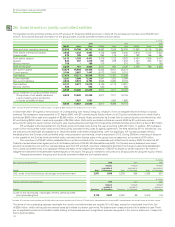BP 2008 Annual Report Download - page 151
Download and view the complete annual report
Please find page 151 of the 2008 BP annual report below. You can navigate through the pages in the report by either clicking on the pages listed below, or by using the keyword search tool below to find specific information within the annual report.
BP Annual Report and Accounts 2008
Notes on financial statements
34. Derivative financial instruments
An outline of the group’s financial risks and the objectives and policies pursued in relation to those risks is set out in Note 28.
IAS 39 prescribes strict criteria for hedge accounting, whether as a cash flow or fair value hedge or a hedge of a net investment in a foreign
operation, and requires that any derivative that does not meet these criteria should be classified as held for trading and fair valued, with gains and
losses recognized in profit or loss.
In the normal course of business the group enters into derivative financial instruments (derivatives) to manage its normal business exposures in
relation to commodity prices, foreign currency exchange rates and interest rates, including management of the balance between floating rate and fixed
rate debt, consistent with risk management policies and objectives. Additionally, the group has a well-established entrepreneurial trading operation that
is undertaken in conjunction with these activities using a similar range of contracts.
The fair values of derivative financial instruments at 31 December are set out below.
$ million
2008 2007
Fair Fair Fair Fair
value value value value
asset liability asset liability
Derivatives held for trading
Currency derivatives 278 (273) 147 (317)
Oil price derivatives 3,813 (3,523) 3,214 (3,432)
Natural gas price derivatives 6,945 (6,113) 4,388 (4,022)
Power price derivatives 978 (904) 1,121 (1,140)
Other derivatives 90 (96) 30 –
12,104 (10,909) 8,900 (8,911)
Embedded derivatives
Commodity contracts 397 (2,264) 255 (2,340)
Interest rate contracts ––– (33)
397 (2,264) 255 (2,373)
Cash flow hedges
Currency forwards, futures and cylinders 120 (1,175) 226 (45)
Cross-currency interest rate swaps 109 (558) 122 (52)
229 (1,733) 348 (97)
Fair value hedges
Cross-currency interest rate swaps 465 (342) 430 (9)
Interest rate swaps 367 – 89 (17)
832 (342) 519 (26)
Hedges of net investments in foreign operations 2 – 40 –
13,564 (15,248) 10,062 (11,407)
Of which – current 8,510 (8,977) 6,321 (6,405)
– non-current 5,054 (6,271) 3,741 (5,002)
Derivatives held for trading
The group maintains active trading positions in a variety of derivatives. The contracts may be entered into for risk management purposes, to satisfy
supply requirements or for entrepreneurial trading. Certain contracts are classified as held for trading, regardless of their original business objective,
and are recognized at fair value with changes in fair value recognized in the income statement. Trading activities are undertaken by using a range of
contract types in combination to create incremental gains by arbitraging prices between markets, locations and time periods. The net of these
exposures is monitored using market value-at-risk techniques as described in Note 28.
The following tables show further information on the fair value of derivatives and other financial instruments held for trading purposes.
Changes during the year in the net fair value of derivatives held for trading purposes were as follows.
$ million
Oil Natural gas Power
Currency price price price Other Total
Fair value of contracts at 1 January 2008 (170) (218) 366 (19) 30 (11)
Contracts realized or settled in the year 24 190 (216) 3 (15) (14)
Fair value of options at inception – (216) (201) 34 – (383)
Fair value of other new contracts entered into during the year – 66 49 – – 115
Changes in fair values relating to price 151 468 881 60 (21) 1,539
Exchange adjustments – – (47) (4) – (51)
Fair value of contracts at 31 December 2008 5 290 832 74 (6) 1,195
150
























